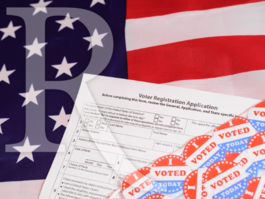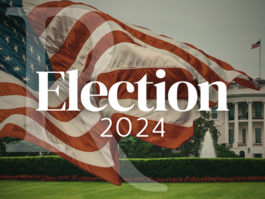Partisan Trends: Republicans 36.0%, Democrats 34.7%, First GOP Lead Ever
In November, 36.0% of American Adults identified themselves as Republicans; 34.7% considered themselves Democrats, and 29.3% were not affiliated with either major party. That’s the largest number of Republicans since February 2005 and the first time ever that Rasmussen Reports polling has found more people identifying as Republicans than Democrats. See the History of Party Trends from January 2004 to the present.
In November 2008, following the presidential election, Democrats held a 7.6 percentage point advantage over the GOP. That means Republicans have picked up a net of approximately nine points over the past two years. That is a somewhat larger gain compared to the Democratic gains from the reelection of President Bush in 2004 to the Democratic takeover of Congress in 2006. However, it is similar to the gains recorded by Democrats during the four-year period from Election 2004 to Election 2008.
In each of the recent election cycles, the victorious party has gained in net partisan identification over the course of the election year.
It is worth noting, however, that the gains are often short-lived. Following Election 2004, the Republican partisan decline began in February 2005. In 2006, the Democratic edge began to decline as soon as they actually took control of Congress in January. Following President Obama’s victory in November 2008, the Democrat’s advantage in partisan identification peaked in December before declining.
Another point worth noting is that the GOP has the edge today partly because the number of Democrats is barely above the lowest level ever recorded in eight years of monthly tracking by Rasmussen Reports. This supports the conclusion that Election 2010 was less a victory for the Republicans than a defeat for the Democrats. A majority of voters expect to be disappointed by the GOP Congress before 2012. Republican voters overwhelmingly believe Republicans in Congress are out of touch with the party’s base.
Rasmussen Reports tracks this information based on telephone interviews with approximately 15,000 adults per month and has been doing so since November 2002. The margin of error for the full sample is less than one percentage point, with a 95% level of confidence.
(Want a free daily e-mail update ? If it's in the news, it's in our polls). Rasmussen Reports updates are also available on Twitter or Facebook.
Rasmussen Reports is a media company specializing in the collection, publication and distribution of public opinion information.
We conduct public opinion polls on a variety of topics to inform our audience on events in the news and other topics of interest. To ensure editorial control and independence, we pay for the polls ourselves and generate revenue through the sale of subscriptions, sponsorships, and advertising. Nightly polling on politics, business and lifestyle topics provides the content to update the Rasmussen Reports web site many times each day. If it's in the news, it's in our polls. Additionally, the data drives a daily update newsletter and various media outlets across the country.
Some information, including the Rasmussen Reports daily Presidential Tracking Poll and commentaries are available for free to the general public. Subscriptions are available for $4.95 a month or 34.95 a year that provide subscribers with exclusive access to more than 20 stories per week on upcoming elections, consumer confidence, and issues that affect us all. For those who are really into the numbers, Platinum Members can review demographic crosstabs and a full history of our data.
To learn more about our methodology, click here.



